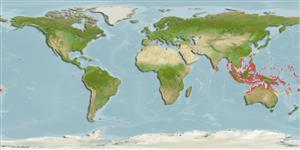Common names from other countries
Environment: milieu / climate zone / depth range / distribution range
Sinh thái học
Biển; Thuộc về nước lợ Cùng sống ở rạn san hô; Mức độ sâu 0 - 20 m (Ref. 48637), usually 0 - 15 m (Ref. 90102). Tropical; 19°C - 38°C (Ref. 1827); 30°N - 30°S, 77°E - 20°W
Indo-West Pacific: India, Sri Lanka, Andaman Islands, Thailand, Malaysia, Singapore, Indonesia, Philippines, Belau [=Palau], Guam, New Guinea, Solomon Islands, Fiji, Vanuatu, ?New Caledonia, ?Western Australia, ?Pohnpei, Caroline Islands, ?Ebon Island and Marshall Islands.
Bộ gần gũi / Khối lượng (Trọng lượng) / Age
Maturity: Lm ? range ? - ? cm
Max length : 45.0 cm TL con đực/không giới tính; (Ref. 1419); common length : 30.0 cm TL con đực/không giới tính; (Ref. 9813); Khối lượng cực đại được công bố: 2.4 kg (Ref. 125599)
Các tia vây lưng cứng (tổng cộng) : 13; Các vây lưng mềm (tổng cộng) : 10; Tia cứng vây hậu môn: 7; Tia mềm vây hậu môn: 9; Động vật có xương sống: 13. Body bluish white; head brown to brownish or golden yellow with irregular blue lines. Preopercular angle 91°-102°; strong overlapping scales cover cheeks; midline of thorax scaled, not pelvic ridges. Anterior nostril with low flange, broadened slightly posteriorly. Spines stout, blunt or pungent, and venomous.
Juveniles live among mangroves then move out to lagoon and coastal reefs as they mature. Forms schools. Feeds on algae growing on seagrasses, mangrove roots and rocks. Adults congregate inshore in groups of several hundreds to spawn in summer. Spawning is by pairs; sticky eggs laid on the bottom. Its very high quality flesh commands premium prices (Ref. 9813). Adults on coastal reefs, subject to strong currents (Ref. 48637). This species can tolerate very low salinities (2 ppt) and temperatures up to 38 C (Ref. 37816).
Throughout summer, adults form inshore breeding groups of several hundred individuals on the 7th or 8th days of the lunar month; pairs break from these groups to spawn. The species has a high fecundity of 350,000/spawning season.
Woodland, D.J., 1990. Revision of the fish family Siganidae with descriptions of two new species and comments on distribution and biology. Indo-Pac. Fish. (19):136 p. (Ref. 1419)
IUCN Red List Status (Ref. 130435)
CITES (Ref. 128078)
Not Evaluated
Human uses
Các nghề cá: Tính thương mại; Nuôi trồng thủy sản: Giống như cách dùng trong tương lai; Bể nuôi cá: Tính thương mại
Các công cụ
Special reports
Download XML
Các nguồn internet
Estimates based on models
Preferred temperature (Ref.
115969): 26.2 - 29.3, mean 28.6 (based on 2941 cells).
Phylogenetic diversity index (Ref.
82804): PD
50 = 0.5000 [Uniqueness, from 0.5 = low to 2.0 = high].
Bayesian length-weight: a=0.01230 (0.00669 - 0.02263), b=3.13 (2.97 - 3.29), in cm Total Length, based on LWR estimates for this species & Genus-body shape (Ref.
93245).
Mức dinh dưỡng (Ref.
69278): 2.0 ±0.00 se; based on food items.
Thích nghi nhanh (Ref.
120179): Trung bình, thời gian nhân đôi của chủng quần tối thiểu là 1.4 - 4.4 năm (K=0.3).
Fishing Vulnerability (Ref.
59153): Low vulnerability (20 of 100).
